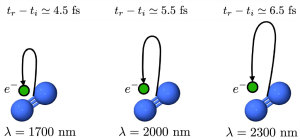New perspectives in time-resolved laser-induced electron diffraction
In this review paper, published in J. Phys. B, we discussed the main achievements of LIED research in terms of experimental results and advanced modeling; and envision interesting perspectives toward the future advancement of time-resolved LIED imaging.
Imaging the microscopic world in real space and real time is a grand challenge of science. In the landscape of time-resolved imaging techniques, laser-induced electron diffraction (LIED) has recently shown to be a promising candidate to push the frontiers of ultrafast molecular imaging. In this review paper, we discussed the main achievements of LIED research in terms of experimental results and advanced modeling. We also envision interesting perspectives toward the future advancement of time-resolved LIED imaging.
The work has been coordinated by Andrea Trabattoni and also involves Jochen Küpper from the CMI group at DESY and Umberto De Giovannini from the Max Planck Institute for the Structure and Dynamics of Matter.
Original Reference:
Umberto De Giovannini, Jochen Küpper and Andrea Trabattoni, New perspectives in time-resolved laser-induced electron diffraction, J. Phys. B: At. Mol. Opt. Phys. 56 054002 (2023), 10.1088/1361-6455/acb872.
